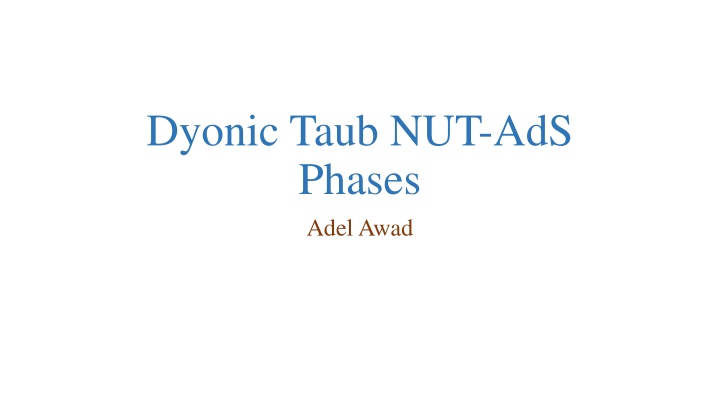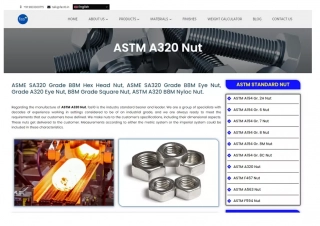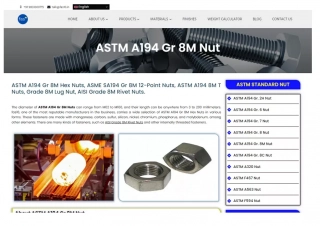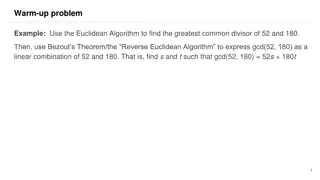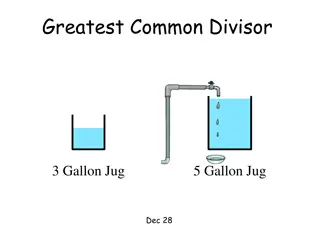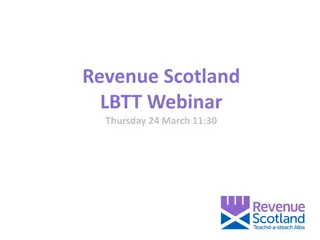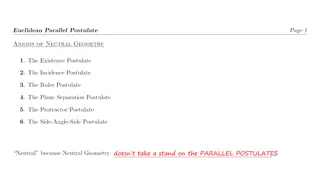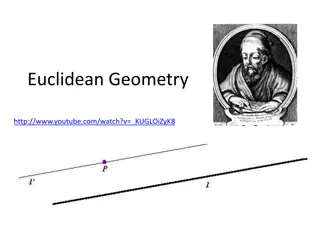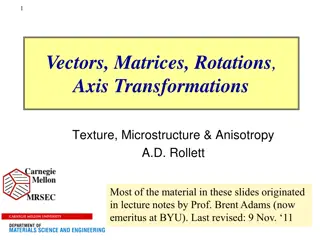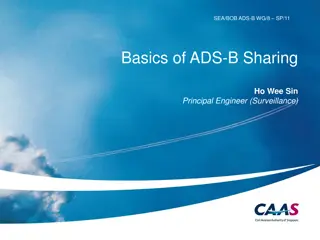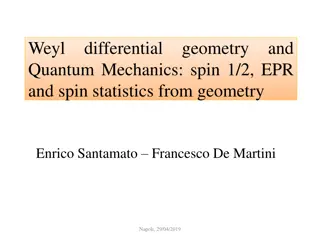Euclidean Path Integral Insights: Dyonic Taub-NUT-AdS Phases
Unlock the complexities of Euclidean Path Integral in Dyonic Taub-NUT-AdS Phases and delve into thermal field theory, gauge potential regularity, statistical ensembles, and phase transitions. Explore the nuances of quantum field theory and the fascinating world of gravitational metrics. Discover the interplay between boundary values and thermodynamics, uncover the significance of saddle point approximation, and understand the concept of phase transitions in intricate detail.
Download Presentation

Please find below an Image/Link to download the presentation.
The content on the website is provided AS IS for your information and personal use only. It may not be sold, licensed, or shared on other websites without obtaining consent from the author.If you encounter any issues during the download, it is possible that the publisher has removed the file from their server.
You are allowed to download the files provided on this website for personal or commercial use, subject to the condition that they are used lawfully. All files are the property of their respective owners.
The content on the website is provided AS IS for your information and personal use only. It may not be sold, licensed, or shared on other websites without obtaining consent from the author.
E N D
Presentation Transcript
Dyonic Taub NUT-AdS Phases Adel Awad
Euclidean Path Integral & Thermal Field Theory In QM PI is defined as qf,tf| qi,ti = D[q] e i I[q] /h = qf| e -i H t|qi q(ti) = qi & q(tf) = qf. In QFT PI is given by Z= f,tf| i,ti = D[ ] e i I[ ] /h= f| e -i H t| i (ti) = i& (tf) = f. QFT at finite temp., i= fand taking t -i . Z = |e - H| =Tr e - H. (in FT without gravity is arbitrary!)
Euclidean Path Integral & Regularity Conditions Z = (g, ) g, | e - H|g, =Tr e - H. (with gravity is not arbitrary!) g and must be regular! Expand Eucl. metric (t i ) around r = r0, ds2 = f(r) d 2+1/f(r) dr2+ Where, f= f0+f (r-r0)+ ds2 = f (r-r0) d 2+1/(f (r-r0)) dr2+ dR=(f (r-r0))-1/2 dr R=2 [ (r-r0)/f ]1/2 ds2 = R2 d(f /2)2 +dR2+ Compare with 2-dim conical space ds2 = R2 d 2 +dR2 , =[ ]=2[ ]/f = 4 /f r = r = r0 2-dim conical space (R, ) coordinates BH boundaries
Euclidean Path Integral & Regularity Conditions Gauge pot. regularity conditions; Aelec =(-q/r+c) dt, as r r0, | Aelec |2 =(-q/r+c) /f (reg. only if ) c = =q/r0! Aelec =(-q/r+c) dt, as r , Aelec =c dt (reg.) c = is fixed! (grand. Canon. Ens.) since I=I(g,A)=I(gb, ). Amag =(p cos( )+c ) d , as r r0 is regular. Amag =(p cos( )+c ) d , as r , p is fixed! (canon. Ens.). I=I(gb,p). Amag =(p cos( )+c ) d , at , =0, ,| Amag |2 =(p cos( )+c )2 /sin( )2, (reg. only if ) c = p! Work term in 1st law, dQ = d(eN) = dN
Euclidean Path Integral & Statistical Ensembles Upon ignoring quant. corrections, the PI is dominated by saddle point approximation, in this limit ZCan = exp(-Ion-sh) = exp(- F), for Canon., F = U-TS (Helmholtz pot.), or, Zgrnd = exp(-Ion-sh) = exp(- G), for Grand Canon., G = U-TS- N (Gibbs pot.) Also, internal energy and entropy are U = - ln Zcan , S = I I.
Euclidean Path Integral & Phase-Transitions Our approach requires that we specify the boundary values of gb and Ab to construct thermodynamics. I=I(gb,Ab)=I( ,p, ) But what if we have more than one solution that have the same boundary values. Z= exp(-I1) + exp(-I2) = = exp(- F1) + exp(- F2) We might have certain range of temp. in which F1< F2, then this could be reversed in another range, F2< F1. In this case we have phase transition! The temp. at which F1= F2, is the transition temp.!
Van der Waals Fluids: Equation of State of real gas: Where v=V/N, a >0, represent corrections due to attractive force between molecules and b>0, represent corrections due to size of molecules. Which can be put as;
Critical Points: P-T diagram Let us consider P=P(v), then Critical points are solutions of Which leads to one point
Behavior around Critical Points: Critical behavior is characterized by power law behavior for certain quantities (critical exponents): Specific heat, Ordered parameter, Compressibility, Pressure at T=Tc,
Gibbs Energy: Gibbs energy is G= 1N1 + 2N2, dN1=-dN2 dG= ( 1 2) dN1 At transition: T1=T2, P1=P2, and G1=G2, 1 = 2 For VdW fluids we get swallowtail behaviors
Charged-AdS solution* Solution: Gravitational action, I= G, Temperature, *R. Mann, et. al arXiv:1205.0559.
TN-Phases* Metric: For the regularity of the 1-form, * A. Awad & E. Elkhateeb PhysRevD.108.064022
TN-Phases Temp. Gibbs Pot. (or action I=G/T) All quantities satisfy 1st law
TN-Phases Critical points (Canon. Case e=0):
TN-Phases We have two c.p s (Canon. Case):
TN-Phases Behavior of Gibbs pot. (Canon. Case):
TN-Phases For qm=? P-T diagram (Canon. Case): 3 :
TN-Phases Critical points (mixed Case, qm=0):
TN-Phases We have similar results to the Canon. Case for mixed Case (qm=0, 1/2 < e<1): But for the mixed Case (qm=0, e 1) we have one crit. point:
